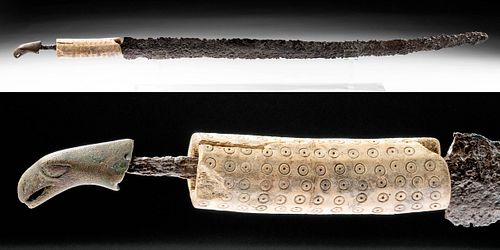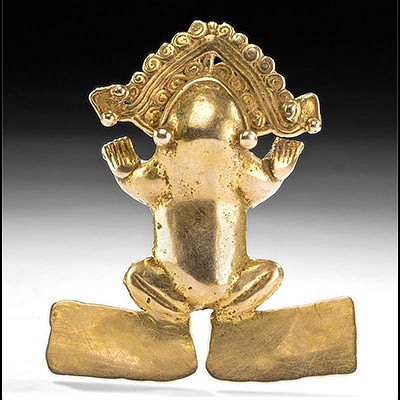Roman Spatha w/ Bone Handle & Bronze Eagle Pommel
Lot 36b
About Seller
Artemis Fine Arts
686 S Taylor Ave, Ste 106
Louisville, CO 80027
United States
Selling antiquities, ancient and ethnographic art online since 1993, Artemis Gallery specializes in Classical Antiquities (Egyptian, Greek, Roman, Near Eastern), Asian, Pre-Columbian, African / Tribal / Oceanographic art. Our extensive inventory includes pottery, stone, metal, wood, glass and textil...Read more
Categories
Estimate:
$6,000 - $9,000
Absentee vs Live bid
Two ways to bid:
- Leave a max absentee bid and the platform will bid on your behalf up to your maximum bid during the live auction.
- Bid live during the auction and your bids will be submitted real-time to the auctioneer.
Bid Increments
| Price | Bid Increment |
|---|---|
| $0 | $25 |
| $300 | $50 |
| $1,000 | $100 |
| $2,000 | $250 |
| $5,000 | $500 |
| $10,000 | $1,000 |
| $20,000 | $2,500 |
| $50,000 | $5,000 |
| $100,000 | $10,000 |
| $200,000 | $20,000 |
About Auction
By Artemis Fine Arts
Aug 13, 2020
Set Reminder
2020-08-13 10:00:00
2020-08-13 10:00:00
America/New_York
Bidsquare
Bidsquare : Fine Antiquities, Ethnographic & Fine Art
https://www.bidsquare.com/auctions/artemis-gallery/fine-antiquities-ethnographic-fine-art-5415
Features classical antiquities, ancient and ethnographic art from cultures encompassing the globe. Egyptian, Greek, Roman, Etruscan, Near Eastern, Asian, Pre-Columbian, Native American, African / Tribal, Oceanic, Spanish Colonial, Russian, Fine Art, so much more! Artemis Fine Arts info@artemisfinearts.com
Features classical antiquities, ancient and ethnographic art from cultures encompassing the globe. Egyptian, Greek, Roman, Etruscan, Near Eastern, Asian, Pre-Columbian, Native American, African / Tribal, Oceanic, Spanish Colonial, Russian, Fine Art, so much more! Artemis Fine Arts info@artemisfinearts.com
- Lot Description
Roman, Imperial Period, ca. 2nd to 4th century CE. A fabulous example of a forged-steel spatha, a sword type typically used by Roman infantrymen for wide slashes and lengthy thrusts that outmatched their enemies. The blade has sharpened edges along both sides that taper to a rounded tip, and a slender tang projects from behind the shoulder. A hand-carved handle made from cow bone is fastened around the tang and features dozens of incised bullseye decorations. A cast-bronze eagle pommel is secured to the end of the tang and features an aquiline beak, slender eyes, and lustrous green patina. Size: 33.6" L x 1.75" W (85.3 cm x 4.4 cm).
The spatha was one of the most prevalent and widely-used weapons in the ancient Roman Empire. According to professor of anthropology Michael D. Coe, "The spatha was of Celtic origin. The Romans were exclusively infantrymen, relying on their allies for cavalry. During the Gallic War, Caesar raised huge bodies of cavalry in Gaul. The Gallic tribes were also the target of Augustus' recruiting efforts when he started to form regular cavalry units to serve alongside the legions operating in the Rhineland. These units were equipped in native fashion with mail shirt, helmet, oval shield, and spear, and the long slashing sword that was to become the spatha, the primary weapon of the middle and later Empire." (Coe, Michael D. et al. "Swords and Hilt Weapons." Barnes & Noble, Inc., New York, 1996, p. 28)
For a strikingly similar example of an iron spatha without a bone handle or pommel, please see: Coe, Michael D., et al. "Swords and Hilt Weapons." Barnes & Noble, Inc., New York, 1996, p. 28, top left example.
This piece has been tested for the presence or absence of particular elements via XRF elemental analysis. A full report is included with the purchase.
Provenance: private J.H. collection, Beaverton, Oregon, USA, acquired in 2012 (blade) and 2014 (eagle pommel); (blade) ex-Ancient Resource, Los Angeles, California, USA; ex-Fortuna Gallery, New York, USA; ex-private English collection; (eagle pommel) ex-Medusa Ancient Art, Montreal, Quebec, Canada; ex-Baltimore Coin & Currency Convention Exhibition, 2008
All items legal to buy/sell under U.S. Statute covering cultural patrimony Code 2600, CHAPTER 14, and are guaranteed to be as described or your money back.
A Certificate of Authenticity will accompany all winning bids.
We ship worldwide and handle all shipping in-house for your convenience.
#149660Bone handle and eagle pommel are ancient but are not original to the sword and were attached in modern times. Blade has slight bending, pitting and oxidation commensurate with age, and light encrustations. Bone handle has losses to some peripheries and light softening to some bullseyes. Bronze pommel attached to tang with modern metallic adhesive. Wonderful patina throughout.Condition
- Shipping Info
-
All shipping is handled in-house for your convenience. Your invoice from Artemis Gallery will include shipping calculation instructions. If in doubt, please inquire BEFORE bidding for estimated shipping costs for individual items.
-
- Buyer's Premium



 EUR
EUR CAD
CAD AUD
AUD GBP
GBP MXN
MXN HKD
HKD CNY
CNY MYR
MYR SEK
SEK SGD
SGD CHF
CHF THB
THB













